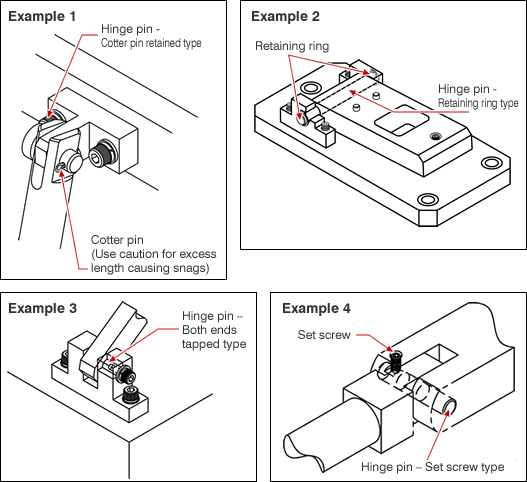#015 Usage Examples of Hinge Pins
Introduced here are some examples of connecting two machine elements together. We have discussed some connection methods for rotating shafts. Here, the discussions will cover some cases on connecting two elements where one is stationary and the other will be moveable.
(1) Connecting Hinge Pins
(1) What is a Hinge?
A hinge is a mechanical element composed of two parts where one is fixed stationary and the other is able to pivot freely. A hinge can be configured using Hinge Pins.
(2) Connecting methods using Hinge Pins.
There are following types.


The Hinge Pins are manufactured with "g6" O.D. tolerance. Mating bores should be made with H7 tolerance to achieve "Slip Fit" connections.
(3) Hints on selecting the connection methods
Evaluate the following check list against the applicable mechanism characteristics to select a proper connection method.
![]()
a) The hinge pin and axial force relationship
Hinge pin retaining strength against the axial force would be as follows.
(Low strength) Cotter pin < Retaining ring < Retaining screw < Nut retained < Female thread < Key retained (High strength)
b)Hinge pin replacement frequency
Cotter pins are one-time use only, cannot be reused.
Key retained type is somewhat cumbersome to work on.
Other methods render for easy replacement.
c) An end of the hinge pin can be grasped or not.
If an end of the hinge pin cannot be grasped due to design constraints or there is a width constraints, the retaining screws or the key retained types can be employed.
(4) Cautionary points on connecting.
| ・ | When using cotter pins, bend the pin at a proper length to avoid snagging on the rotation section. |
Connection methods for linear motion components, next.
- Positioning technology
- Designing and processing
- Sensor Technology
- Automation elements technology
- Clean room technology
- Design hints
- Design tips
- Designing and Machining
- Drive mechanism design
- Hints on designing
- Linear Motion Components
- Locating Technology
- Manufacturing technology
- Motion mechanism design
- Pneumatic Drives
- Production Technology
- Technology Outlook
- General description
- Low-cost automation and materials
- Transfer LCA
- #333 Know-how on automation: Pressurized heating technology - 5: Multilayer pressurized heating process technique
- #332 Know-how on automation: Pressurized heating technology - 4: Points to remember when designing mechanism of pneumatic pressurization method
- #331 Know-how on automation: Pressurized heating technology - 3: Pneumatic pressurization method and pressure profile
- #330 Know-how on automation: Pressurized heating technology - 2: Pressurization method and pressure profile
- #329 Know-how on automation: Pressurized heating technology



